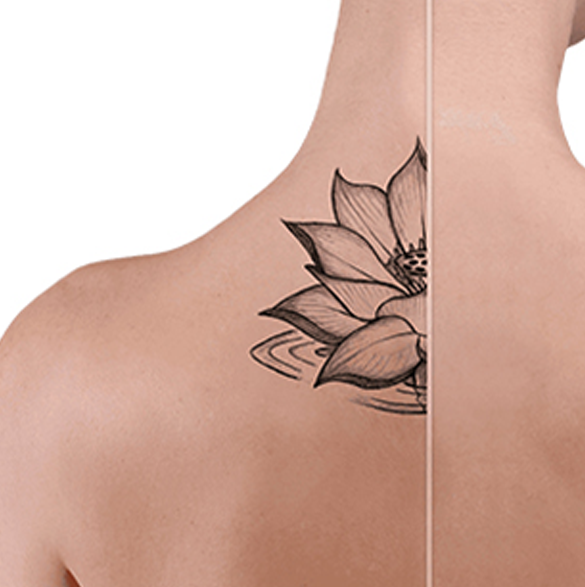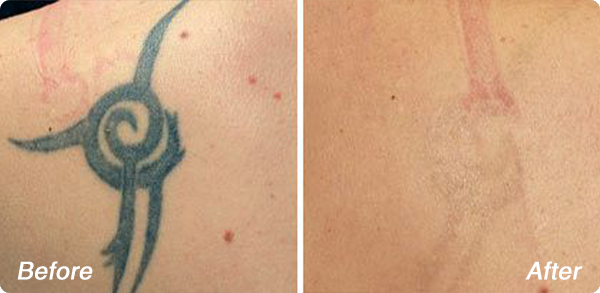Tattoo Removal
Q-Switched lasers are the ideal tools for effectively removing complex and multi-colored tattoos. Multi-wavelength, Q-Switched laser systems with frequency-doubled KTP are uniquely able to produce very short pulses of intense light that pass harmlessly through the top layers of skin to be selectively absorbed by treatment-specific pigments.
Highest Energy for Maximum Effectiveness
Fotona’s Q-Switched laser technology generates high-energy nanosecond pulses that are efficient at removing many types of tattoos. By using larger spot sizes at very high energy, deeper-lying pigmented structures can be reached and removed, and laser treatment efficacy and efficiency in a single session are significantly enhanced.


Different Wavelengths for Multicolored Tattoos
Fotona’s Q-Switched lasers offer four wavelengths in one system – enabling treatments for virtually all commonly used pigment colors. Extremely short energy pulses cause tattoo pigments to break into smaller particles, which are then removed by the body’s own immune system. Most tattoo procedures take only a few minutes, but several treatments are typically needed to completely remove a tattoo. Three-week intervals between sessions are required to allow pigment residue to be cleared by the body.
HOW CAN WE HELP ?
Patented Technology for Safer & More Precise Treatments
Homogeneity of a laser beam profile ensures greater safety during treatments since laser energy is evenly distributed across the treated area. Epidermal damage is minimized and the risk of bleeding, tissue splatter and transient textural changes in the skin is decreased. Fotona’s advanced Q-switched laser technology relies on groundbreaking solutions such as patented OPTOflex® and Vacuum Cell Technologies to produce an almost perfectly homogeneous beam profile, resulting in safer and more effective treatments for your patients.
Tattoo removal treatments can be best performed with the following Fotona laser system:
StarWalker – StarWalker’s MaQX peak energy, four colors and proprietary FracTAT® procedure make StarWalker an industry-leading, ultra-performance laser-tattoo-removal system.
QX MAX – the highest performance single-pulse Q-Switched laser on the market. With four wavelengths in one system, the QX MAX provides all the tools you’ll need for effective removal of most types of pigmented and vascular lesions as well as complex, multi-colored tattoos.
Superior Performance
High-energy, single-nanosecond pulse technology is vastly more efficient at removing pigments than multiple-pulse lasers that generate equivalently high energies. The StarWalker’s and QX MAX’s high-energy, single-pulse Q-switched lasers allow larger spot sizes to remain effective by avoiding the scattering effect of laser light in skin tissue. With high-energy single pulses, more and deeper-lying pigments can be targeted and removed.
With high-energy laser pulses, the use of larger spot sizes is enabled, requiring less fluence to be effective and reducing the risk of unwanted side effects such as tissue splatter, bleeding and textural changes.
In addition, by performing Fotona’s patented FracTAT® tattoo removal procedure, treatment efficacy and efficiency in a single session are further maximized.
Fotona’s innovative FracTAT® procedure can be performed with the ASP-powered StarWalker laser system. Micro holes are first drilled into the skin using a special ablative laser handpiece and MaQX10 laser pulses. Micro holes act as pressure-relief ducts through which the gasses produced during the treatment can escape without building up excessive pressure. This enables the laser to reach deeper-lying pigments and facilitates faster removal of color pigments from the skin.
Handpieces & Accessories
Fotona’s line of specially designed, advanced and easy-to-use Titanium handpieces allow safe, precise, controlled and effective delivery of laser pulses to the treatment area.
TESTIMONIALS
What Practitioners Think about Fotona
Fotona4D® face-lifting tackles problems of laxity around the mouth and jowls, which other systems or surgery will find difficult to address. This is a relatively painless procedure with no downtime.





